Influence of Carbon Fiber-Reinforced Ropes Applied as External Diagonal Reinforcement on the Shear Deformation of RC Joints
Abstract
:1. Introduction
2. Design Purpose of the Joint Specimens
2.1. Characteristics of Specimens—Materials
2.2. Examination of the Expected Damage
2.3. Group A Specimens
2.4. Group B Specimens
3. Test Setup and Measurement of Shear Deformations
4. Test Results and Evaluation
4.1. Shear Deformations—Comparative Presentation and Remarks
4.2. Principal Stresses—Comparative Presentation and Remarks
5. Concluding Remarks
- From the comparative presentation of the observed joint shear deformations of specimens JB1 and JB1Fx it can be observed that the X-form C-FRP cords substantially improved the behavior of the joint in specimen JB1Fx. The ratios of the measured shear deformations of the strengthened specimen JBIFX over the shear deformations of the reference unstrengthened specimen JB1 were 0.13–0.28 for high story drifts (2.0–4.0). Thereupon, it can be observed that the externally mounted C-FRP cords kept the joint body of specimen JB1Fx almost intact and efficiently reduced the shear deformations.
- Systematic and extended comparative presentations of the shear deformation of specimens with and without ropes proved in all the examined cases that the externally mounted C-FRP ropes kept the joint body almost intact and substantially reduced the shear deformations especially in high drifts. Thus, it can be concluded that the application of the C-FRP ropes for the strengthening of beam—column connections either designed according to modern codes or deficient ones proved to be an efficient and easy to apply technique.
- Moreover, the influence of the externally mounted X-shaped C-FRP ropes on the seismic behaviour of these specimens has been also examined in terms of the developing principal tensile stresses inside the joint body. From the comparisons of the principal stresses developing in specimens with X-form C-FRP ropes to the reference specimen JB1 it has been yielded that in all the examined cases the ropes kept the joint body intact and allowed the development of higher values of principal stresses comparing to the stresses developing in specimen JB1 without ropes where the joint body severely damaged.
Author Contributions
Funding
Institutional Review Board Statement
Informed Consent Statement
Data Availability Statement
Acknowledgments
Conflicts of Interest
References
- De Risi, M.T.; Del Vecchio, C.; Ricci, P.; Ludovico, M.D.; Prota, A.; Verderame, G.M. Light FRP Strengthening of poorly detailed reinforced concrete exterior beam-column joints. J. Compos. Constr. 2020, 24, 04020014. [Google Scholar] [CrossRef]
- Karayannis, C.G.; Sirkelis, G.M. Strengthening and rehabilitation of RC beam-column joints using FRP jacketing and epoxy resin injections. J. Earthq. Eng. Struct. Dyn. 2008, 37, 769–790. [Google Scholar] [CrossRef]
- Tsonos, A.G. Ultra-high-performance fiber reinforced concrete: An innovative solution for strengthening old R/C structures and for improving the FRP strengthening method. WIT Trans. Eng. Sci. 2008, 64, 273–284. [Google Scholar] [CrossRef] [Green Version]
- Karayannis, C.G.; Golias, E. Fullscale tests of RC joints with minor to moderate damage repaired using C-FRP sheets. Earthq. Struct. 2018, 15, 617–627. [Google Scholar] [CrossRef]
- Pohoryles, D.A.; Melo, J.; Rossetto, T.; Varum, H.; Bisby, L. Seismic retrofit schemes with FRP for deficient RC beam-column joints: State-of-the-art review. J. Compos. Constr. 2019, 23, 4. [Google Scholar] [CrossRef] [Green Version]
- Murad, Y.; Al Bodur, W.; Ashteyat, A. Seismic retrofitting of severely damaged RC connections made with recycled concrete using CFRP sheets. Front. Struct. Civ. Eng. 2020, 14, 554–568. [Google Scholar] [CrossRef]
- Tafsirojjaman, T.; Fawzia, S.; Thambiratnam, D.P. Structural behaviour of CFRP strengthened beam-column connections under monotonic and cyclic loading. Structures 2021, 33, 2689–2699. [Google Scholar] [CrossRef]
- Mostofinejad, D.; Akhlaghi, A. Experimental Investigation of the Efficacy of EBROG Method in Seismic Rehabilitation of Deficient Reinforced Concrete Beam–Column Joints Using CFRP Sheets. J. Compos. Constr. 2017, 21, 04016116. [Google Scholar] [CrossRef]
- Mostofinejad, D.; Akhlaghi, A. Flexural strengthening of reinforced concrete beam column joints using innovative anchorage system. ACI Struct. J. 2017, 114, 1603–1614. [Google Scholar] [CrossRef]
- Hamzah, M.K.; Rashid, R.S.M.; Hejazi, F. Cyclic performance of exterior RC beam-column strengthened with different thicknesses of CFRP sheets. IOP Conf. Ser. Earth Environ. Sci. 2022, 961, 012069. [Google Scholar] [CrossRef]
- Al-Rousan, R.Z.; Sharma, A. Integration of FRP sheet as internal reinforcement in reinforced concrete beam-column joints exposed to sulfate damaged. Structures 2021, 31, 891–908. [Google Scholar] [CrossRef]
- Al-Mahmoud, F.; Castel, A.; François, R.; Tourneur, C. Strengthening of RC members with near-surface mounted CFRP rods. Compos. Struct. 2009, 91, 138–147. [Google Scholar] [CrossRef]
- Dalfre, G.M.; Barros, J.A.O. NSM technique to increase the load carrying capacity of continuous RC slabs. Eng. Struct. 2013, 56, 137–153. [Google Scholar] [CrossRef] [Green Version]
- Alwash, D.; Kalfat, R.; Al-Mahaidi, R.; Du, H. Shear strengthening of RC beams using NSM CFRP bonded using cement based adhesive. Constr. Build. Mater. 2021, 301, 124365. [Google Scholar] [CrossRef]
- Murad, Y.Z.; Alseid, B.H. Retrofitting interior RC beam-to-column joints subjected to quasi-static loading using NSM CFRP ropes. Structures 2021, 34, 4158–4168. [Google Scholar] [CrossRef]
- MohammadiFirouz, R.; Pereira, E.; Barros, J. Thermo-mechanical Bonding Behaviour of CFRP NSM System Using Cement-Based Adhesive. In Proceedings of the 10th International Conference on FRP Composites in Civil Engineering, Istanbul, Turkey, 8–10 December 2021; Lecture Notes in Civil Engineering. Springer: Cham, Switzerland, 2021; Volume 19, pp. 287–299. [Google Scholar] [CrossRef]
- Al-Saadi, N.T.K.; Mohammed, A.; Al-Mahaidi, R.; Sanjayan, J. A state-of-the-art review: Near-surface mounted FRP composites for reinforced concrete structures. Constr. Build. Mater. 2019, 209, 748–769. [Google Scholar] [CrossRef]
- Marchisella, A.; Muciaccia, G.; Sharma, A.; Eligehausen, R. Experimental investigation of 3d RC exterior joint retrofitted with fully-fastened-haunch-retrofit-solution. Eng. Struct. 2021, 239, 112206. [Google Scholar] [CrossRef]
- Yu, F.; Feng, C.; Fang, Y.; Liu, Q.; Hu, Y.; Bu, S. Experimental study on low-strength concrete joint core strengthened with steel meshes for connecting PFCC column and RC beam. Adv. Struct. Eng. 2021, 24, 797–814. [Google Scholar] [CrossRef]
- Ruiz-Pinilla, J.G.; Cladera, A.; Pallares, F.J.; Calderon, P.A.; Adam, J.M. Joint strengthening by external bars on RC beam-column joints. J. Build. Eng. 2022, 45, 103445. [Google Scholar] [CrossRef]
- Ebanesar, A.; Gladston, H.; Noroozinejad Farsangi, E.; Sharma, S.V. Strengthening of RC beam-column joints using steel plate with shear connectors: Experimental investigation. Structures 2022, 35, 1138–1150. [Google Scholar] [CrossRef]
- Araby, Z.; Abdullah, A.; Affifuddih, M. Analysis of reinforced concrete beam-column joint structures retrofitting. IOP Conf. Ser. Mater. Sci. Eng. 2020, 933, 012037. [Google Scholar] [CrossRef]
- Al-Rousan, R.Z.; Alkhawaldeh, A. Numerical simulation of the influence of bond strength degradation on the behavior of reinforced concrete beam-column joints externally strengthened with FRP sheets. Case Stud. Constr. Mater. 2021, 15, e00567. [Google Scholar] [CrossRef]
- Golias, E.; Zapris, A.G.; Kytinou, V.K.; Kalogeropoulos, G.I.; Chalioris, C.E.; Karayannis, C.G. Effectiveness of the novel rehabilitation method of seismically damaged rc joints using c-frp ropes and comparison with widely applied method using c-frp sheets—experimental investigation. Sustainability 2021, 13, 6454. [Google Scholar] [CrossRef]
- Chalioris, C.E.; Kosmidou, P.-M.K.; Papadopoulos, N.A. Investigation of a new strengthening technique for RC deep beams using carbon FRP ropes as transverse reinforcements. Fibers 2018, 6, 52. [Google Scholar] [CrossRef] [Green Version]
- Karayannis, C.G.; Golias, E. Full-scale experimental testing of RC beam-column joints strengthened using CFRP ropes as external reinforcement. Eng. Struct. 2022, 250, 113305. [Google Scholar] [CrossRef]
- Karayannis, C.G.; Golias, E. Strengthening of deficient RC joints with diagonally placed C-FRP ropes. Earthq. Struct. 2021, 20, 123–132. [Google Scholar] [CrossRef]
- Rashmi, M.; Anand, V.N.; Balaji, N.C. Shear strengthening of RC beams using near surface mounted technique with glass fiber reinforced polymer. AIP Conf. Proc. 2021, 2327, 020012. [Google Scholar] [CrossRef]
- De Lorenzis, L.; Teng, J.G. Near-surface mounted FRP reinforcement: An emerging technique for strengthening structures. Compos. Part B Eng. 2007, 38, 119–143. [Google Scholar] [CrossRef]
- Tsonos, A.G. A model for the evaluation of the beam-column joint ultimate strength—A more simplified version. Earthq. Struct. 2019, 16, 141–148. [Google Scholar] [CrossRef]
- Tsonos, A.G. An innovative solution for strengthening of old R/C structures and for improving the FRP strengthening method. Struct. Monit. Maint. 2014, 1, 323–338. [Google Scholar] [CrossRef]
- Kalogeropoulos, G.I.; Tsonos, A.-D.G.; Konstandinidis, D.; Tsetines, S. Pre-Earthquake and Post-Earthquake Retrofitting of Poorly Detailed Exterior RC Beam-to-Column Joints. Eng. Struct. 2016, 109, 1–15. [Google Scholar] [CrossRef]
- Tsonos, A.G. Effectiveness of CFRP jackets in post-earthquake and pre-earthquake retrofitting of beam-column subassemblages. Struct. Eng. Mech. 2007, 27, 393–408. [Google Scholar] [CrossRef]
- Verderame, G.M.; De Risi, M.T.; Ricci, P. Experimental investigation of exterior unreinforced beam-column joints with plain and deformed bars. J. Earthq. Eng. 2016, 22, 404–434. [Google Scholar] [CrossRef]
- Bonacci, J.F.; Wight, J.K. Displacement-based assessment of reinforced concrete frames in earthquakes. ACI Spec. Publ. 1996, 162, 117–138. [Google Scholar]
- Golias, E.; Zapris, A.G.; Kytinou, V.K.; Osman, M.; Koumtzis, M.; Siapera, D.; Chalioris, C.E.; Karayannis, C.G. Application of X-shaped CFRP ropes for Structural Upgrading of Reinforced Concrete Beam-Column Joints under Cyclic Loading—Experimental Study. Fibers 2021, 9, 42. [Google Scholar] [CrossRef]
- Golias, E.; Lindenthal, H.; Franz-Hermann Schlüter, F.H.; Karabinis, A. Ertüchtigung seismisch beschädigter Rahmenknoten aus Stahlbeton mittels FRP-Filamentbündelverbindungen. Bautechnik 2020, 97, 268–278. [Google Scholar] [CrossRef]
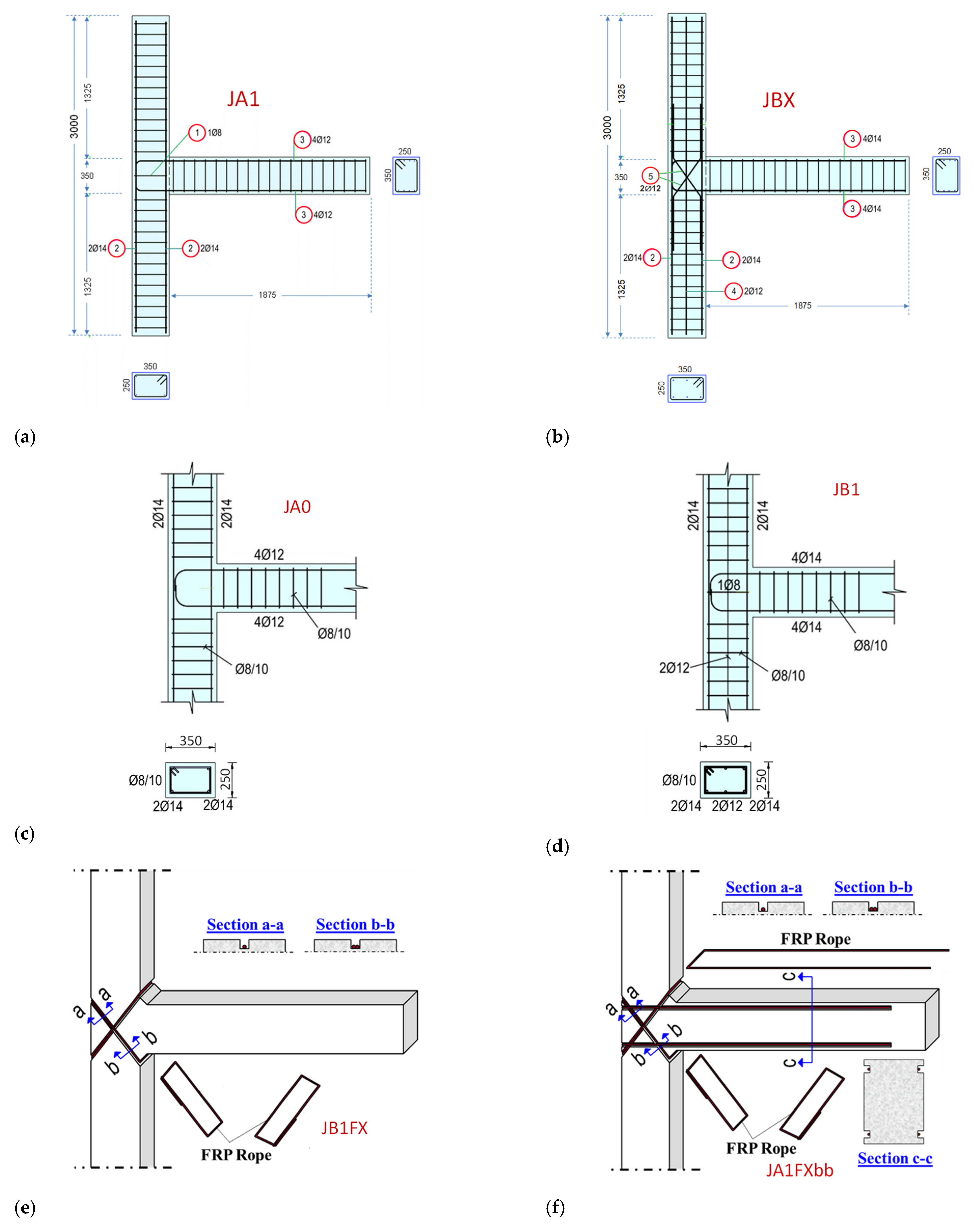
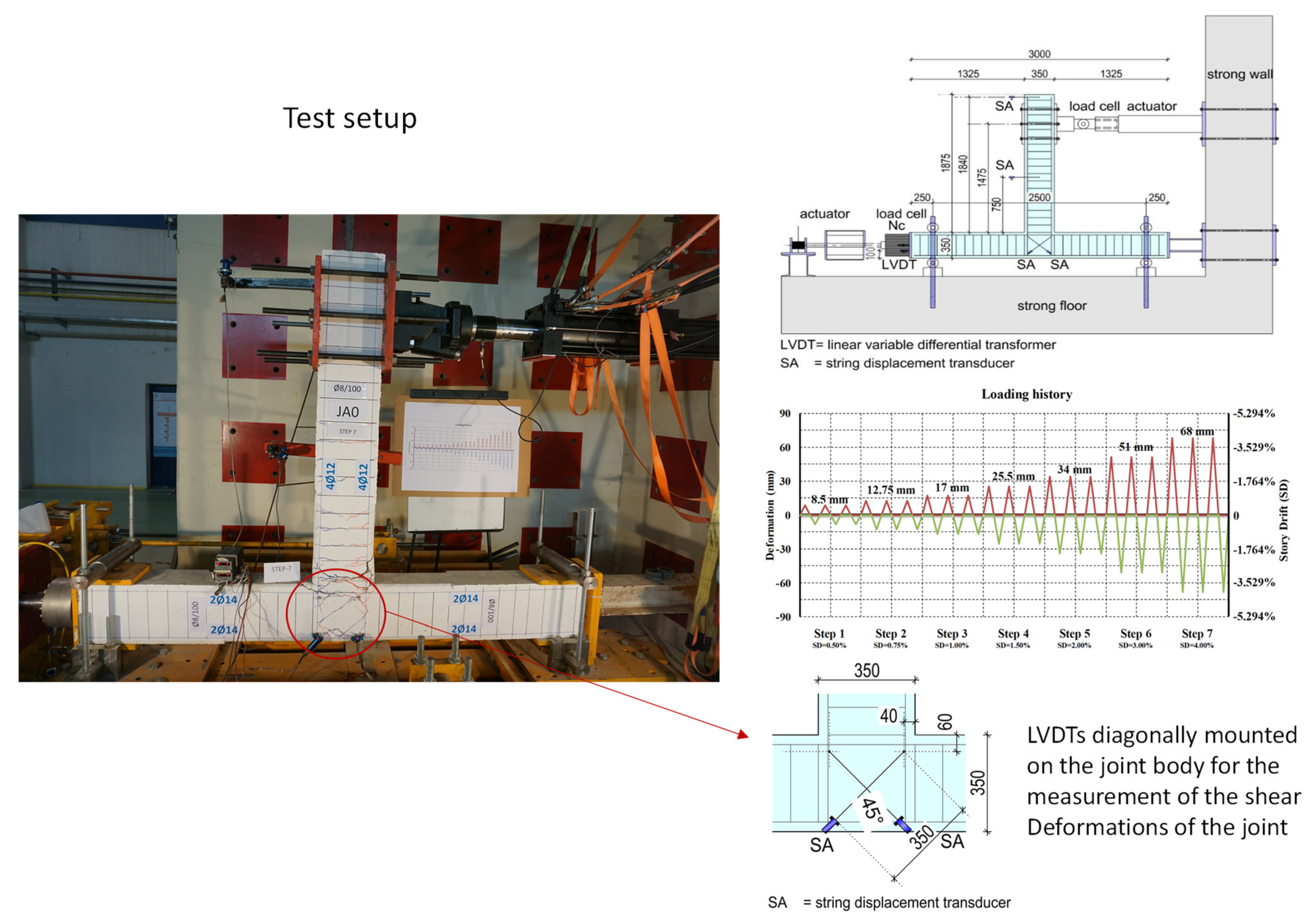
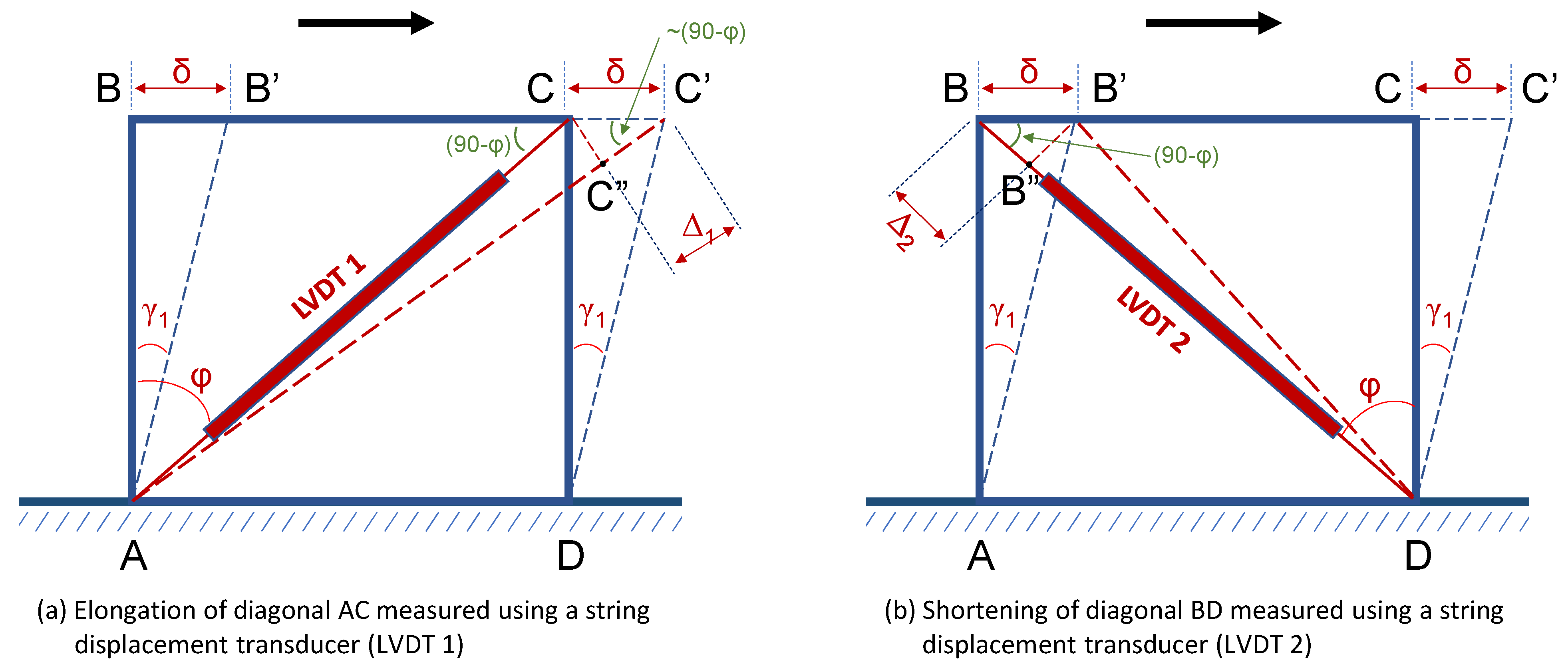

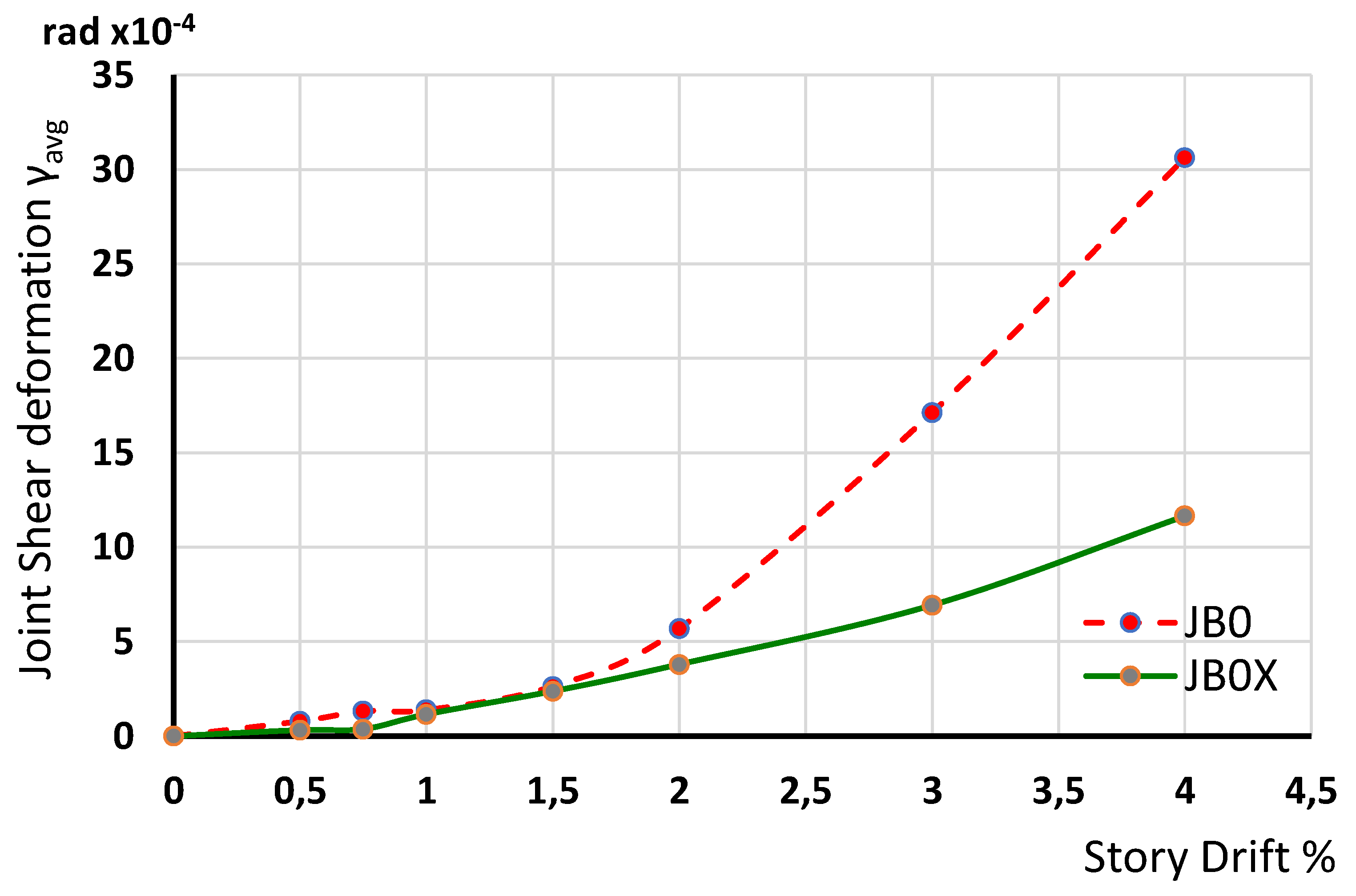

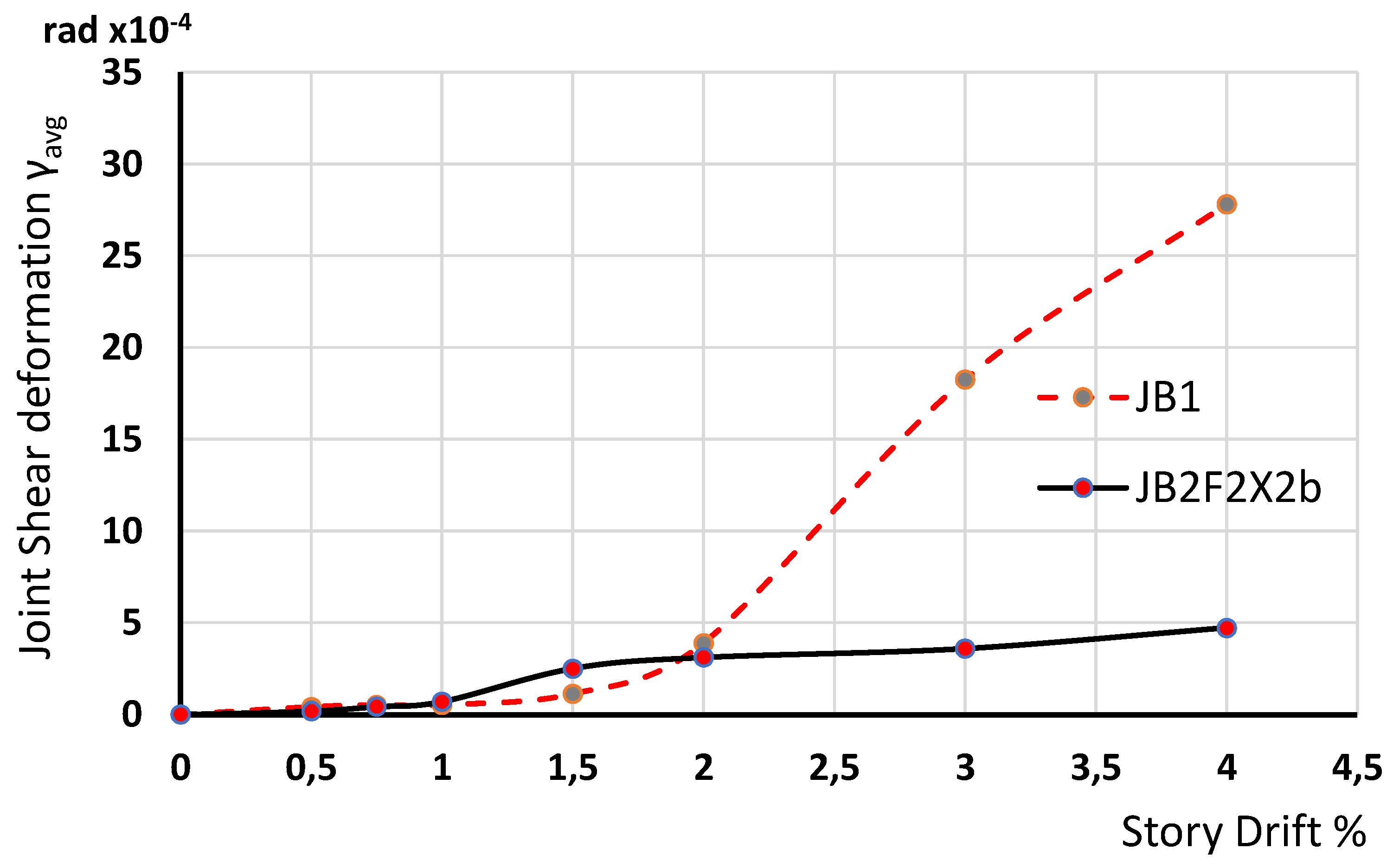
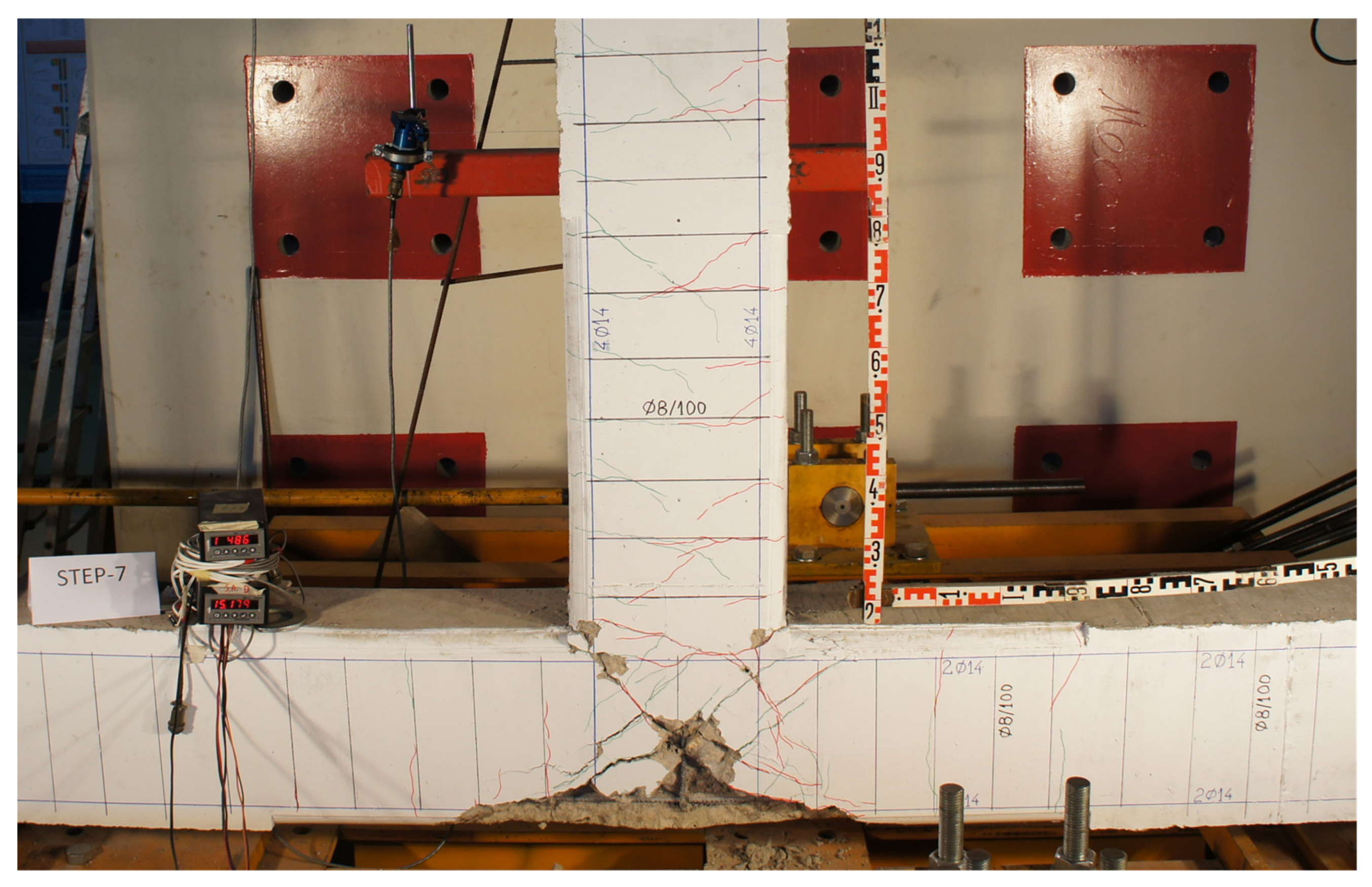
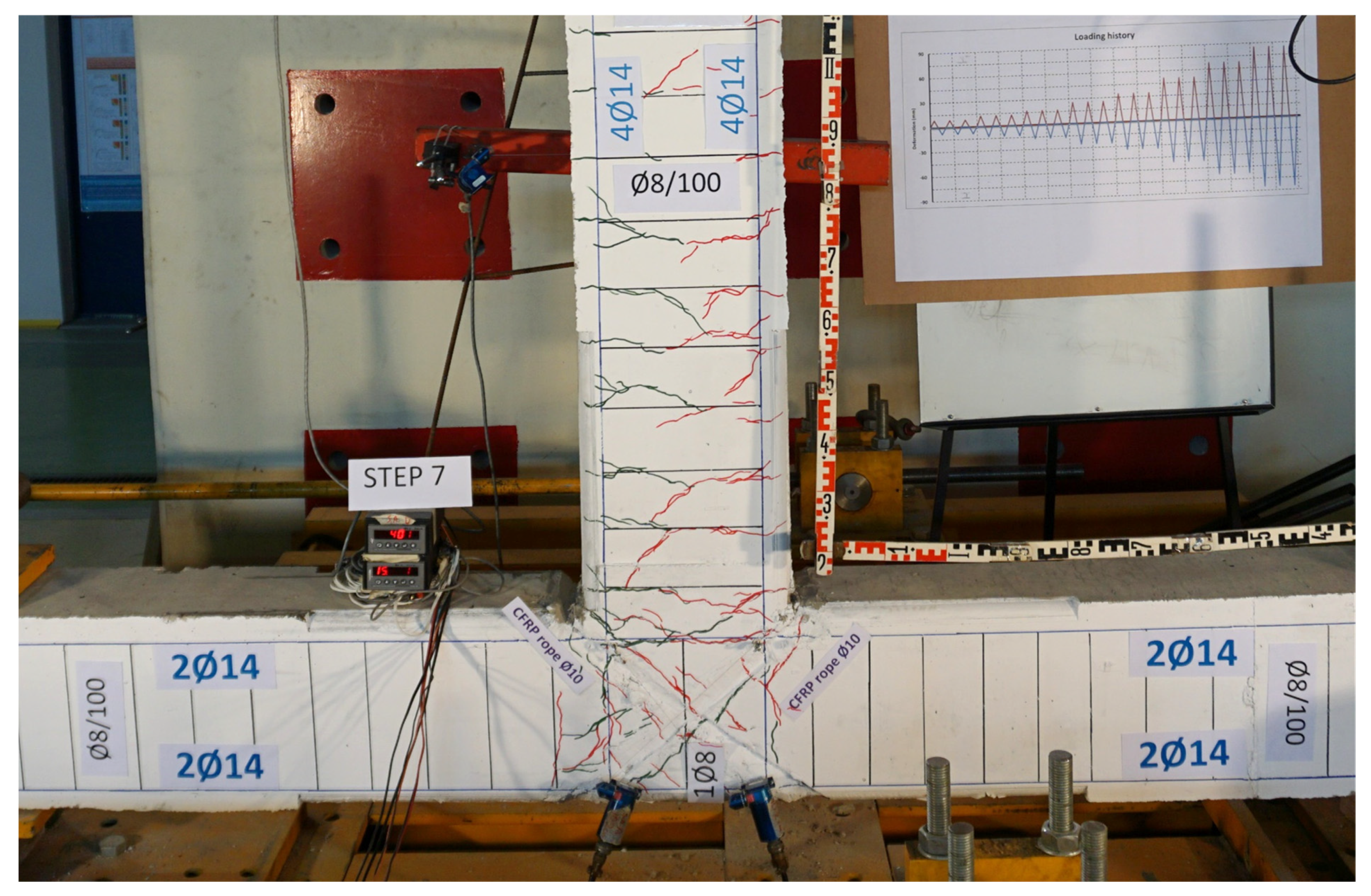
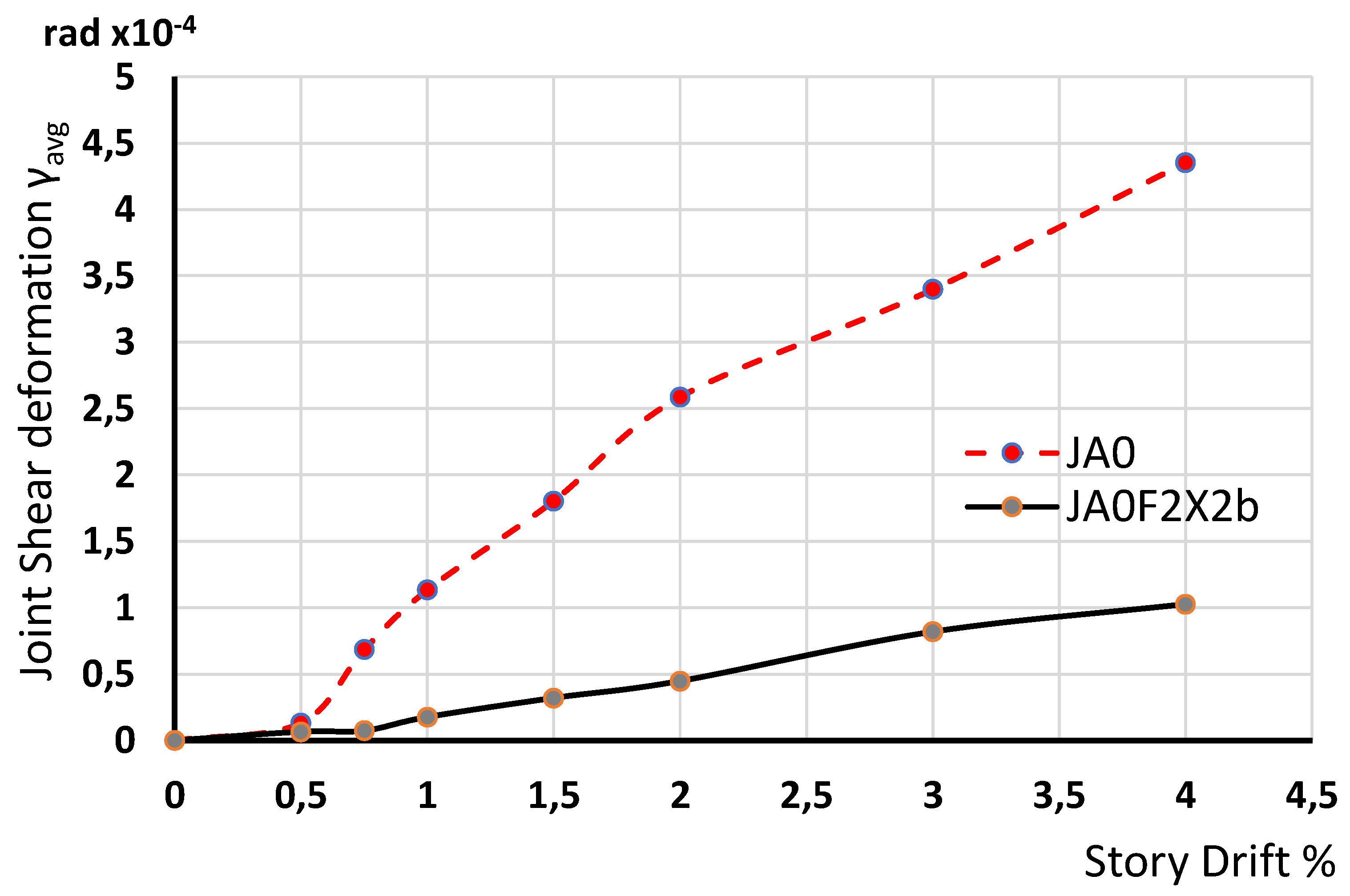
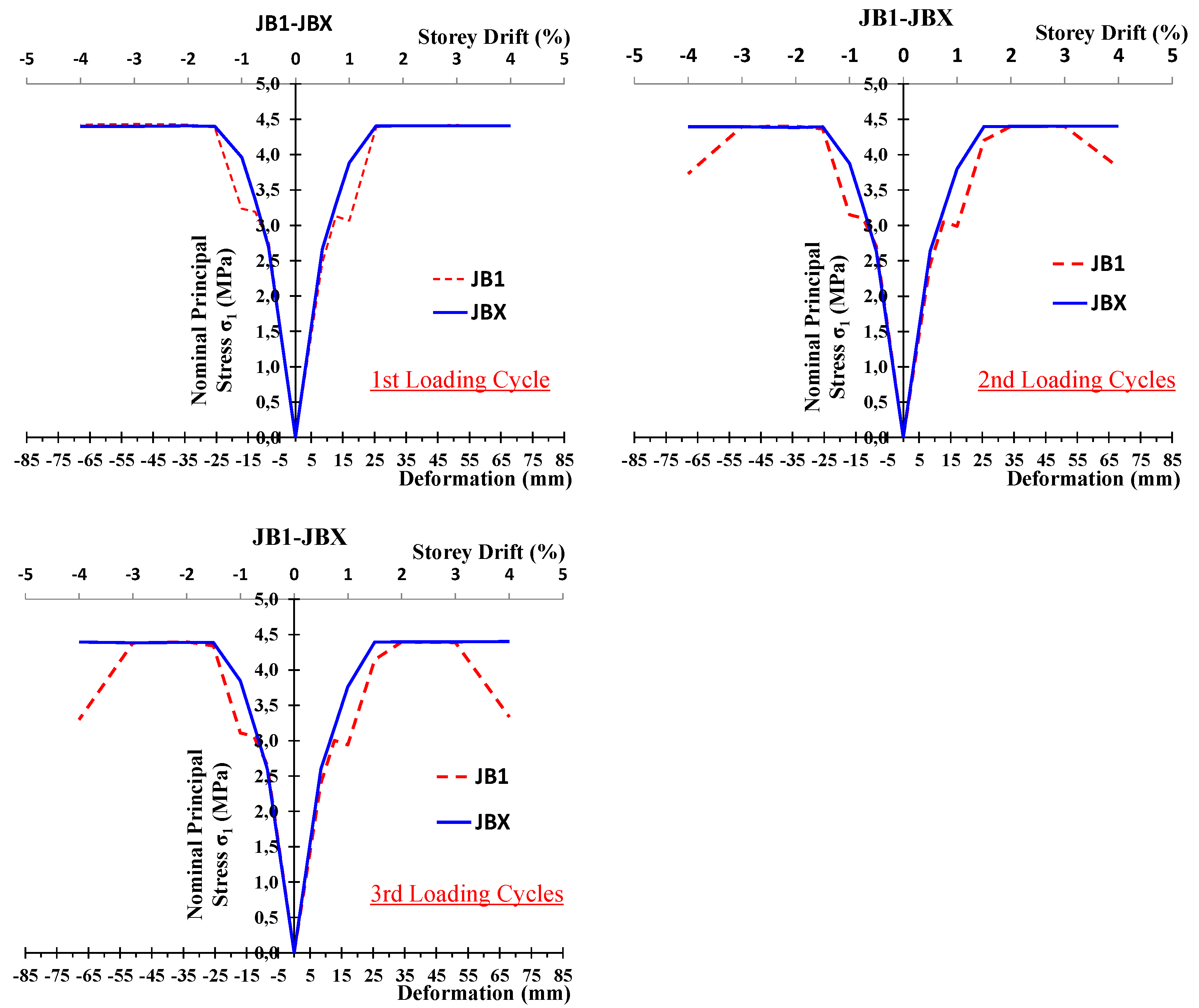
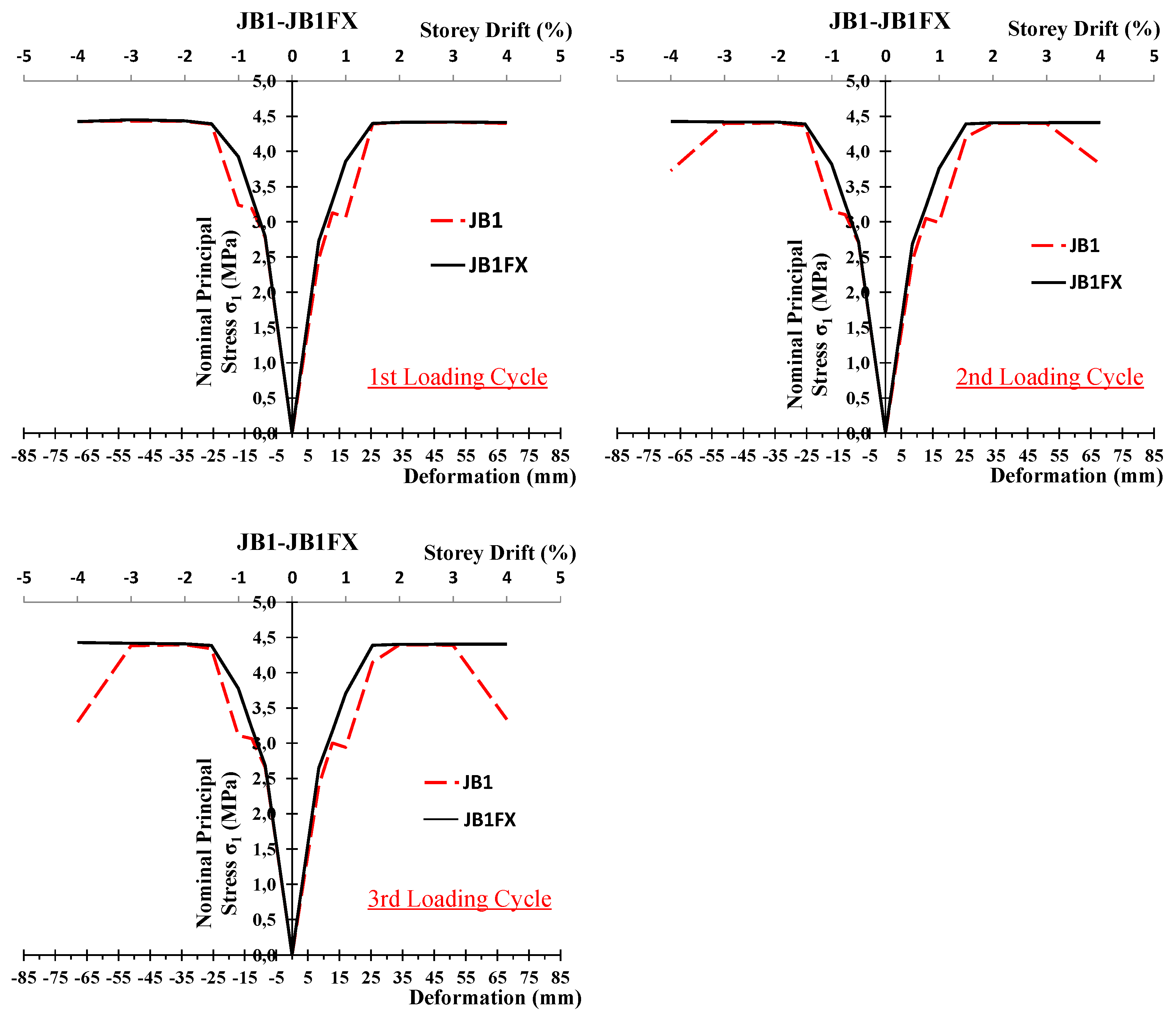

| Reinforcements | JA0 | JA0F2x2b | JA1 | JA1F2x2b | JB0 | JB1 | JBX | JB1Fx | JB2F2x2b |
|---|---|---|---|---|---|---|---|---|---|
 | - | - | 1Ø8 | 1Ø8 | - | 1Ø8 | 1Ø8 | 1Ø8 | 2Ø8 |
 | 2Ø14 | 2Ø14 | 2Ø14 | 2Ø14 | 2Ø14 | 2Ø14 | 2Ø14 | 2Ø14 | 2Ø14 |
 | 4Ø12 | 4Ø12 | 4Ø12 | 4Ø12 | 4Ø14 | 4Ø14 | 4Ø14 | 4Ø14 | 4Ø14 |
 | - | 2Ø12 | - | 2Ø12 | 2Ø12 | 2Ø12 | 2Ø12 | - | 2Ø12 |
 | - | - | - | - | - | - | 2Ø12 | - | - |
| FRP ropes of joint | - | X-type Double rope | - | X-type Double rope | - | - | - | X-type Single rope | X-type Double rope |
| FRP ropes of beam | - | Double rope | - | Double rope | - | - | - | - | Double rope |
| Shear Deformations γavg rad × 10−4 | ||
|---|---|---|
| Drift | JB1 | JB1FX |
| 1.5 | 1.139 | 0.875 |
| 2.0 | 3.899 | 0.981 |
| 3.0 | 18.262 | 2.291 |
| 4.0 | 27.797 | 7.902 |
Publisher’s Note: MDPI stays neutral with regard to jurisdictional claims in published maps and institutional affiliations. |
© 2022 by the authors. Licensee MDPI, Basel, Switzerland. This article is an open access article distributed under the terms and conditions of the Creative Commons Attribution (CC BY) license (https://creativecommons.org/licenses/by/4.0/).
Share and Cite
Karayannis, C.; Golias, E.; Kalogeropoulos, G.I. Influence of Carbon Fiber-Reinforced Ropes Applied as External Diagonal Reinforcement on the Shear Deformation of RC Joints. Fibers 2022, 10, 28. https://doi.org/10.3390/fib10030028
Karayannis C, Golias E, Kalogeropoulos GI. Influence of Carbon Fiber-Reinforced Ropes Applied as External Diagonal Reinforcement on the Shear Deformation of RC Joints. Fibers. 2022; 10(3):28. https://doi.org/10.3390/fib10030028
Chicago/Turabian StyleKarayannis, Chris, Emmanouil Golias, and George I. Kalogeropoulos. 2022. "Influence of Carbon Fiber-Reinforced Ropes Applied as External Diagonal Reinforcement on the Shear Deformation of RC Joints" Fibers 10, no. 3: 28. https://doi.org/10.3390/fib10030028
APA StyleKarayannis, C., Golias, E., & Kalogeropoulos, G. I. (2022). Influence of Carbon Fiber-Reinforced Ropes Applied as External Diagonal Reinforcement on the Shear Deformation of RC Joints. Fibers, 10(3), 28. https://doi.org/10.3390/fib10030028








